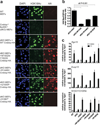CREBBP mutations in relapsed acute lymphoblastic leukaemia
- PMID: 21390130
- PMCID: PMC3076610
- DOI: 10.1038/nature09727
CREBBP mutations in relapsed acute lymphoblastic leukaemia
Abstract
Relapsed acute lymphoblastic leukaemia (ALL) is a leading cause of death due to disease in young people, but the biological determinants of treatment failure remain poorly understood. Recent genome-wide profiling of structural DNA alterations in ALL have identified multiple submicroscopic somatic mutations targeting key cellular pathways, and have demonstrated substantial evolution in genetic alterations from diagnosis to relapse. However, DNA sequence mutations in ALL have not been analysed in detail. To identify novel mutations in relapsed ALL, we resequenced 300 genes in matched diagnosis and relapse samples from 23 patients with ALL. This identified 52 somatic non-synonymous mutations in 32 genes, many of which were novel, including the transcriptional coactivators CREBBP and NCOR1, the transcription factors ERG, SPI1, TCF4 and TCF7L2, components of the Ras signalling pathway, histone genes, genes involved in histone modification (CREBBP and CTCF), and genes previously shown to be targets of recurring DNA copy number alteration in ALL. Analysis of an extended cohort of 71 diagnosis-relapse cases and 270 acute leukaemia cases that did not relapse found that 18.3% of relapse cases had sequence or deletion mutations of CREBBP, which encodes the transcriptional coactivator and histone acetyltransferase CREB-binding protein (CREBBP, also known as CBP). The mutations were either present at diagnosis or acquired at relapse, and resulted in truncated alleles or deleterious substitutions in conserved residues of the histone acetyltransferase domain. Functionally, the mutations impaired histone acetylation and transcriptional regulation of CREBBP targets, including glucocorticoid responsive genes. Several mutations acquired at relapse were detected in subclones at diagnosis, suggesting that the mutations may confer resistance to therapy. These results extend the landscape of genetic alterations in leukaemia, and identify mutations targeting transcriptional and epigenetic regulation as a mechanism of resistance in ALL.
Figures


References
-
- Mullighan CG, et al. Genome-wide analysis of genetic alterations in acute lymphoblastic leukaemia. Nature. 2007;446:758–764. - PubMed
-
- Kuiper RP, et al. High-resolution genomic profiling of childhood ALL reveals novel recurrent genetic lesions affecting pathways involved in lymphocyte differentiation and cell cycle progression. Leukemia. 2007;21:1258–1266. - PubMed
-
- Goodman RH, Smolik S. CBP/p300 in cell growth, transformation, and development. Genes Dev. 2000;14:1553–1577. - PubMed
-
- Pui CH, Robison LL, Look AT. Acute lymphoblastic leukaemia. Lancet. 2008;371:1030–1043. - PubMed
Publication types
MeSH terms
Substances
Grants and funding
LinkOut - more resources
Full Text Sources
Other Literature Sources
Medical
Research Materials

